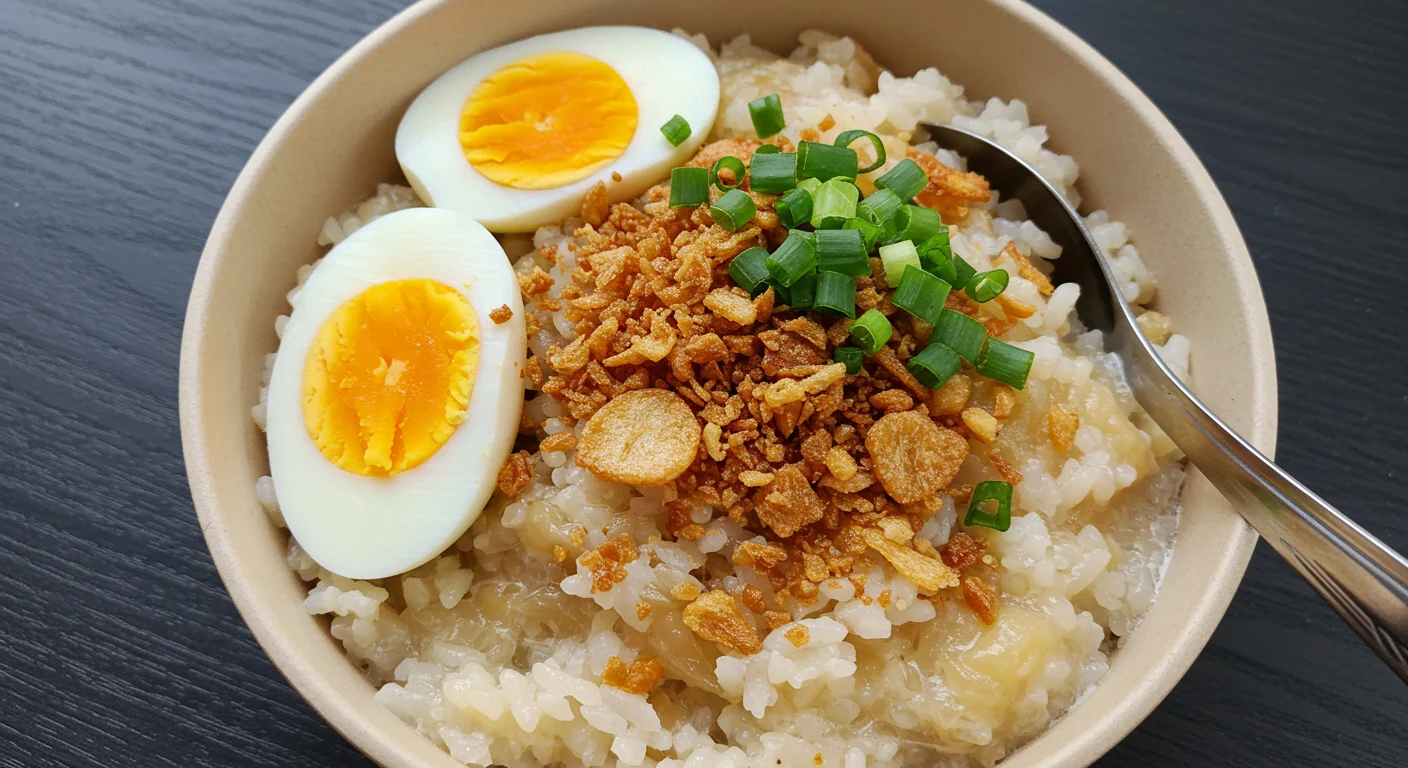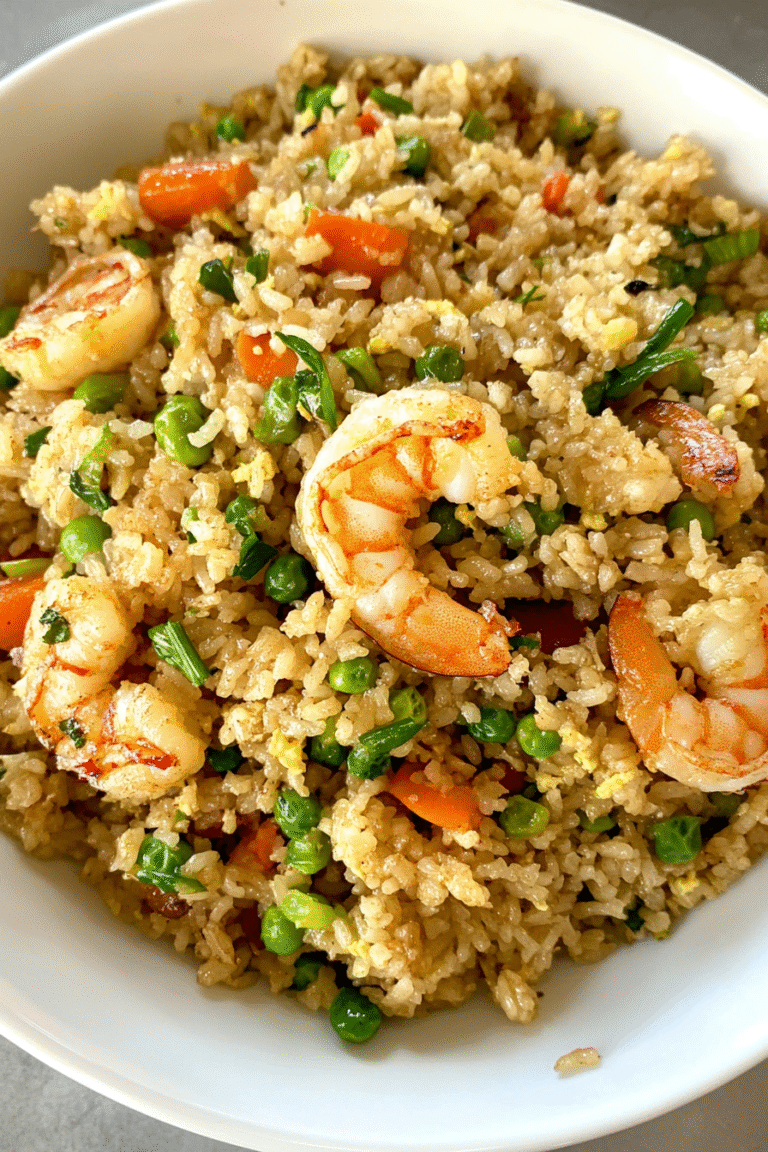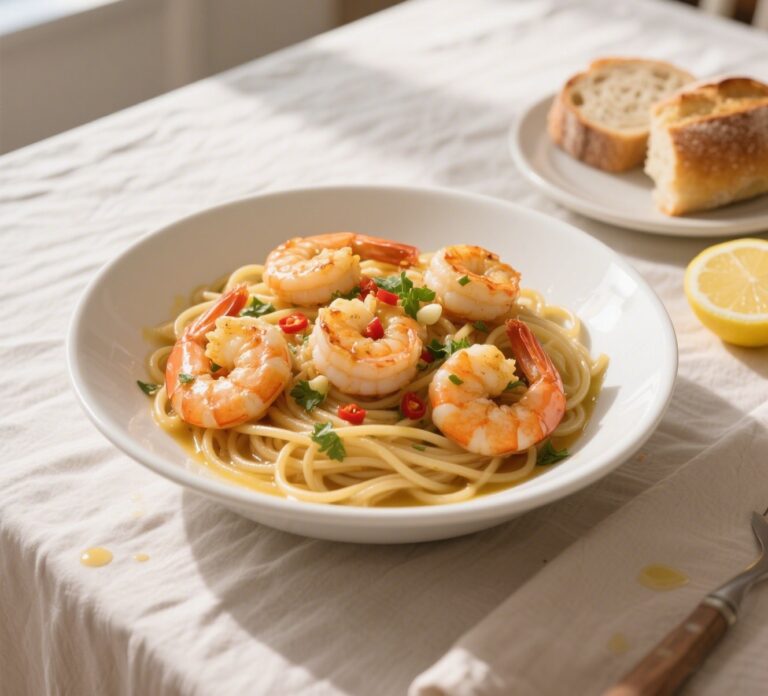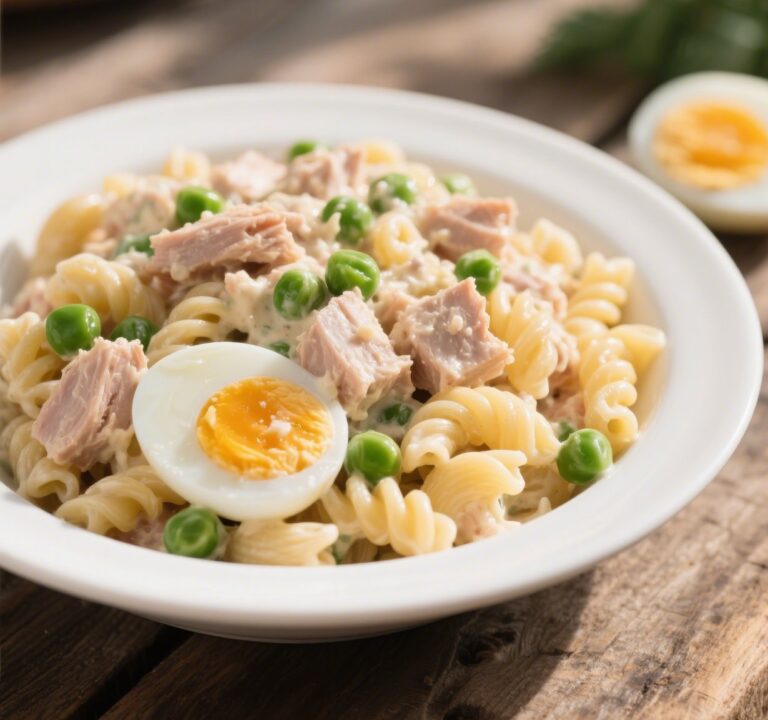Arroz Caldo (Filipino Chicken and Rice Soup): The Ultimate Comfort Bowl

When it comes to Filipino comfort food, Arroz Caldo sits right at the top. This hearty chicken and rice soup, infused with garlic, ginger, and fish sauce, warms the soul and fills the belly—perfect for chilly days, under-the-weather moments, or simply when you crave a taste of home.
This article takes you on a deep dive into Arroz Caldo’s origins, ingredients, cooking techniques, variations, and nutritional perks. You’ll also discover how it differs from lugaw, rice porridge, and other rice soups—plus pro tips for storing leftovers and getting that golden-yellow hue the dish is known for.
Discover great ideas like this classic rice dish in our Fried Rice Recipe.
What Is Arroz Caldo?
Origin of Arroz Caldo in Filipino Cuisine
Arroz Caldo comes from Spanish influence during the Philippines’ colonial period—“arroz” means rice and “caldo” means broth. But don’t let the Spanish name fool you—this dish is Filipino through and through. Inspired by Chinese congee, Arroz Caldo evolved to include local flavors like calamansi, fish sauce, and fried garlic.
Unlike other rice porridge varieties across Asia, Arroz Caldo emphasizes flavor depth. Its defining characteristics? Sautéed chicken, plenty of garlic and ginger, and that unmistakable aromatic richness from simmered homemade stock.
Over time, it became more than just food—it became a comfort ritual. Filipino families often prepare Arroz Caldo during the rainy season or serve it as a nourishing recovery meal for the sick or elderly.
Cultural Significance and Traditional Role in Filipino Homes
In Filipino homes, Arroz Caldo isn’t just a dish—it’s an emotion. It’s that bowl your mom makes when you’re feeling down, or the meal that warms you up after coming in from the rain. It brings back childhood memories, evokes the smell of garlic crisping in oil, and reminds you of home no matter where you are in the world.
Traditionally, it’s served with boiled eggs, scallions, and a generous sprinkle of crispy garlic bits. But every household has its own twist. Some add safflower (kasubha) for color, others finish it off with a squirt of calamansi juice for brightness. No matter the version, it remains a symbol of comfort and care.
Key Ingredients in Arroz Caldo
Essential Ingredients and Their Roles
Creating an unforgettable bowl of Arroz Caldo starts with fresh, quality ingredients. Each one plays a specific role in building flavor, texture, and aroma.
Here’s a breakdown of the essentials:
| Ingredient | Purpose in the Dish |
|---|---|
| Canola Oil | Used to fry garlic and sauté chicken for a rich base |
| Minced Garlic | Adds depth, aroma, and texture—especially when fried |
| Chicken Thighs | Tender, juicy protein that simmers into the broth |
| Onion & Ginger | Build a savory, aromatic foundation |
| Fish Sauce | Delivers umami and a touch of briny saltiness |
| Black Pepper | Balances the warm flavors and adds mild heat |
| Jasmine Rice | Provides creaminess and body when simmered |
| Chicken Stock | The soul of the soup—use homemade for best results |
| Calamansi or Lime Juice | Adds brightness and cuts through richness |
| Scallions & Fried Garlic | Classic toppings for crunch and visual appeal |
| Boiled Eggs (optional) | Traditional garnish that adds protein and color |
What makes this dish truly Filipino is the layered cooking process. Frying the garlic separately ensures crisp texture, while sautéing the aromatics and chicken infuses the soup with complexity.

Don’t miss our go-to mix for chicken stir-fries like this one in Chicken and Vegetable Stir Fry.
How to Cook Authentic Arroz Caldo
Step-by-Step Cooking Process
Making Arroz Caldo from scratch may look simple on paper, but timing, layering, and technique make all the difference. Below is a detailed step-by-step guide using the traditional ingredients shared earlier.
- Fry the Garlic for Topping
In a small saucepan, heat 1/2 cup of canola oil over medium heat. Add 2/3 of the minced garlic and cook, stirring occasionally, until golden brown. - Tip: Don’t walk away—burnt garlic turns bitter fast. Strain the garlic, spread it on a paper towel to crisp, and set it aside. This step creates that classic Filipino garlic crunch topping.
- Sauté Chicken and Aromatics
In a large Dutch oven, heat the remaining 3 tablespoons of oil until shimmering. Add the bite-sized chicken thighs and cook until lightly browned. Add the sliced onion, cooking until softened. Toss in the rest of the garlic and freshly minced ginger, cooking until golden and fragrant. - Season and Toast the Rice
Stir in 1 tablespoon of fish sauce and black pepper. Add 1 cup of uncooked jasmine rice, stirring to coat each grain in flavor. - Simmer to Perfection
Pour in 6 cups of chicken stock, scraping up any browned bits from the bottom. Bring to a boil, then lower to a simmer. Cover the pot and cook for about 30 minutes, stirring occasionally, until the rice is tender and the broth thickens. - Finish with Citrus & Salt
Once the consistency is creamy and rich—not watery—add 1 tablespoon of calamansi or lime juice. Taste and adjust with salt and pepper as needed. - Serve and Garnish
Ladle the hot Arroz Caldo into bowls. Top each serving with:- Crispy fried garlic
- Thinly sliced scallions
- Optional hard-boiled eggs
- A wedge of calamansi or lime on the side
Looking for creamy pasta vibes? Try this Creamy Garlic Chicken Pasta.
Tips for Getting the Perfect Consistency
- Stir occasionally while simmering to prevent the rice from sticking to the bottom and to break down the grains slightly.
- If the broth thickens too much before the rice is soft, just add more stock or water a bit at a time.
- Want it thicker? Cook uncovered for the last 5–10 minutes to let more liquid evaporate.
- Prefer soupy Arroz Caldo? Add a splash of warm broth right before serving to loosen it up.
This dish is all about balance—creamy but not mushy, savory with a hit of brightness, hearty yet easy to digest.
Nutritional Value and Health Benefits
Calories, Macronutrients, and Key Vitamins
At first glance, Arroz Caldo may seem like a simple comfort food, but it packs a surprisingly nutritious punch. Here’s a snapshot of the nutrient profile based on one hearty serving:
| Nutrient | Amount per Serving | % Daily Value |
|---|---|---|
| Calories | 497 kcal | — |
| Total Fat | 24g | 31% |
| Saturated Fat | 5g | 25% |
| Cholesterol | 208mg | 69% |
| Sodium | 1728mg | 75% |
| Carbohydrates | 25g | 9% |
| Dietary Fiber | 3g | 9% |
| Sugars | 3g | — |
| Protein | 49g | — |
| Vitamin C | 24mg | 120% |
| Calcium | 103mg | 8% |
| Iron | 4mg | 22% |
| Potassium | 975mg | 21% |
Source: Nutritional data calculated based on a standard 4-serving recipe.
With nearly 50 grams of protein, this dish is highly satisfying and ideal for those looking to boost muscle recovery or stay full longer. It’s also high in Vitamin C, thanks to fresh citrus juice, and offers moderate iron and potassium—crucial for energy and heart health.
Health Benefits of Arroz Caldo Ingredients
Each component of Arroz Caldo contributes to its healing reputation, particularly among Filipinos:
- Chicken thighs provide lean, flavorful protein and essential B vitamins.
- Ginger acts as a natural anti-inflammatory and aids digestion.
- Garlic supports immune function and contains powerful antioxidants.
- Fish sauce, though salty, is rich in amino acids that enhance flavor without adding MSG.
- Calamansi or lime juice boosts Vitamin C levels, helping your body fight off colds.
This makes Arroz Caldo a go-to dish for those recovering from illness. It’s light on the stomach, yet rich in nutrients, which explains its long-standing role as a traditional “get well soon” meal in the Philippines.
And because you can control the ingredients—like lowering the sodium or using brown rice—you can make it as light or hearty as needed.
Learn more about citrus choices like calamansi in our guide on How to Make Fresh Lemon Juice.
Best Toppings and Side Pairings
Traditional Garnishes: Eggs, Garlic, Calamansi
What takes Arroz Caldo from “just soup” to a full sensory experience? The toppings.
Each garnish adds flavor, texture, and visual appeal. Here are the classics:
- Fried Garlic Bits
- Adds crunch, aroma, and that signature golden finish
- Made by slow-frying minced garlic in oil until crispy
- Sprinkle generously over the bowl before serving
- Hard-Boiled Eggs
- Sliced into quarters and laid gently on top
- Adds protein and transforms the dish into a complete meal
- Optional, but commonly used for added richness
- Scallions (Green Onions)
- Thinly sliced and sprinkled raw over hot soup
- Offers fresh, oniony bite and bright green contrast
- Calamansi or Lime Wedges
- Served on the side for diners to squeeze in as desired
- The acidity cuts through the richness and enhances all flavors
These toppings are more than just aesthetic—they’re part of the traditional arroz caldo experience and add layers of flavor that make every spoonful exciting.
Side Dishes that Elevate the Experience
Arroz Caldo is a complete meal on its own, but in Filipino households, it’s often paired with sides that enhance the comfort factor or contrast the warm porridge texture.
Here are some perfect pairings:
| Side Dish | Why It Works |
|---|---|
| Pandesal (Filipino bread rolls) | Soft, slightly sweet bread that soaks up the broth |
| Tokwa’t Baboy (tofu & pork) | A crunchy, tangy vinegar dish that cuts through the creaminess |
| Lumpiang Shanghai (Filipino spring rolls) | Crispy and savory, they add a satisfying crunch |
| Salted Duck Eggs | Salty and creamy—balances the mildness of the soup |
| Acharang Papaya (pickled papaya) | Adds a punch of acidity and texture contrast |
Want a quick lunch pairing? A simple boiled egg and pan de sal combo works beautifully.
Looking for lighter bites? Try this wrap in our Veggie Wrap with Hummus.
What Makes Arroz Caldo Yellow?
The Role of Safflower (Kasubha) or Turmeric
One of the most visually distinct features of Filipino Arroz Caldo is its golden-yellow hue. But what exactly gives it that color?
In the Philippines, many home cooks and traditional recipes use kasubha—also known as safflower—to achieve that signature golden tint. Kasubha is often called “poor man’s saffron,” as it resembles saffron in color but is far more affordable and more widely available in local markets.
Here’s how it works:
- Kasubha is added during the simmering stage to infuse color into the broth.
- It imparts a slightly floral aroma but doesn’t overpower the dish.
- It doesn’t significantly change the taste, allowing the garlic, ginger, and chicken to remain the stars.
Want a more accessible alternative? Turmeric works beautifully, too.
Color vs. Flavor: Myths and Facts
There’s a common misconception that Arroz Caldo’s color means it contains curry powder or strong spices. In truth, traditional Arroz Caldo is relatively mild and does not include those bold Indian or Thai spices.
Let’s break it down:
| Coloring Ingredient | Adds Flavor? | Adds Color? |
|---|---|---|
| Kasubha (Safflower) | Very mild | Yes |
| Turmeric | Slightly earthy | Yes |
| Curry Powder | Strong, spicy | Yes, but changes dish |
| Annatto Oil | Nutty, mild | Yes (uncommon in arroz caldo) |
If your Arroz Caldo is vibrantly yellow, it likely contains turmeric. If the yellow tone is more muted and warm, it probably came from kasubha.
Ultimately, the color is symbolic. It hints at the warmth, comfort, and heart that this dish brings. And now that global health trends highlight turmeric’s anti-inflammatory benefits, it’s become a welcome addition even in traditional Filipino kitchens.
Looking for inspiration? Try color-rich recipes like our How to Make Fresh Lemon Juice.
Serving, Storage, and Reheating Tips
How to Store Leftover Arroz Caldo Properly
Arroz Caldo makes fantastic leftovers—if stored right. As the rice continues to absorb liquid even after cooking, it’s important to refrigerate it quickly and safely.
Storage Instructions:
- Let the dish cool to room temperature before storing.
- Transfer to an airtight container.
- Refrigerate for up to 4 days.
For longer storage, you can freeze Arroz Caldo, though the texture may change slightly when thawed.
Freezer Tips:
- Portion it into individual containers for grab-and-go meals.
- Freeze for up to 2 months.
- Defrost overnight in the fridge before reheating.
Keep garnishes like fried garlic, boiled eggs, and scallions separate until ready to serve.
Reheating Methods That Keep It Creamy
Because Arroz Caldo thickens as it sits, reheating it needs a gentle hand. Here’s how to bring it back to its original comforting consistency:
Stovetop (Best Method)
- Pour into a saucepan over low heat.
- Add a splash of chicken stock or water to loosen it up.
- Stir occasionally to avoid burning at the bottom.
- Heat until it reaches your desired temperature.
Microwave (Quickest Method)
- Place in a microwave-safe bowl.
- Stir in a few tablespoons of broth or water.
- Cover with a damp paper towel.
- Heat on medium for 1–2 minutes, stirring halfway through.
Avoid overheating, which can dry out the rice or make the soup too mushy. Always re-season with a dash of salt, pepper, or calamansi juice after reheating to refresh the flavor.
Try more cozy, spoon-worthy meals like our Creamy Garlic Chicken Pasta.
Frequently Asked Questions About Arroz Caldo
What is the difference between arroz caldo and lugaw?
While both arroz caldo and lugaw are Filipino rice porridges, arroz caldo is specifically flavored with ginger, garlic, fish sauce, and often includes chicken, giving it a savory and robust taste. Lugaw, on the other hand, is more of a bland rice porridge base, which can be sweet or savory depending on the add-ins. Arroz caldo also usually has a yellowish tint from safflower or turmeric, which is rarely present in lugaw.
What’s the difference between rice soup and rice porridge?
Rice soup typically contains more liquid, making it more like a broth-based dish with rice as an ingredient, while rice porridge like arroz caldo is thicker and creamier, with the rice partially breaking down during cooking. Rice soup may be served clear and light, whereas porridge has a hearty, almost creamy texture from the simmered rice.
Is arroz caldo a porridge?
Yes, arroz caldo is a type of rice porridge, similar to Chinese congee, but with distinctly Filipino ingredients and flavors. It’s made by simmering rice in chicken stock until it becomes soft and porridge-like. What sets arroz caldo apart is the addition of ginger, garlic, and fish sauce, plus toppings like fried garlic, boiled eggs, and scallions.
What makes arroz caldo yellow in the Philippines?
The yellow color in traditional Filipino arroz caldo often comes from kasubha (safflower), a local spice that gives it a subtle hue without altering the flavor. In modern recipes, some cooks use a small amount of turmeric powder as a substitute, which gives it a richer yellow tint and also adds nutritional value. The color is mostly for visual appeal and cultural identity.






